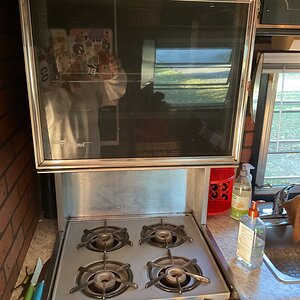Navigation
Install the app
How to install the app on iOS
Follow along with the video below to see how to install our site as a web app on your home screen.
Note: This feature may not be available in some browsers.
More options
Welcome to RVForums.com
- Register now and join the discussion
- Friendliest RV Community on the web
- Modern site for PC's, Phones, Tablets - no 3rd party apps required
- Ask questions, help others, review campgrounds
- Get the most out of the RV Lifestyle
- Invite everyone to RVForums.com and let's have fun
- Commercial/Vendors welcome
You are using an out of date browser. It may not display this or other websites correctly.
You should upgrade or use an alternative browser.
You should upgrade or use an alternative browser.
KOA to start installing J1772 on campground pedestals for charging electric vehicles.
- Thread starter Voyageurs
- Start date
I wouldn't say all KOA's are going to do this as some KOA's are really old and many CG's don't have the infrastructure to support RV's much less EV's. Niagara Falls comes to mind when I was there in a July I think it was and it was constant brown/black outs.
@Jim I think a CG like yours a single station would suffice, not per campsite. And the user would have to pay. I've venture to guess learn how Tesla charging stations are going to handle payment, they're not all free from what I hear. In fact if you're not too far off the beaten path you could possibly advertise Tesla charging on what I assume Tesla would have listed as charging stations and have another revenue option. But again, I would not do per site, but just have one station for now if you're really considering doing this.
But yeah, what is the flat tow capability? I've had a little of the Tesla bug but have been holding off. We haven't gotten to the point with Tesla's where it's time for battery replacement. Owners probably think it's maintenance free. Wait until they're quoted a battery replacement or whatever else with batteries.
I tend to agree Neal. Those who have the capacity to add a few 60 amp breakers will and those that are maxed out won’t. They can still have a revenue stream from charging but it would have to be at the site using the customers equipment. And of course with the policy of RV’s and EV’s don’t get plugged in at the same time.
I wouldn’t put in Tesla specific charging. Just use the industry standard J1772 L2 stations. That way every EV from every manufacturer can plug in including Tesla. Teslas come with a little adapter so they can do this.
Hope that helps.
Jim
RVF Supporter
- Joined
- Dec 18, 2019
- Messages
- 4,309
- Location
- North Carolina
- RV Year
- 2016
- RV Make
- Newmar
- RV Model
- London Aire 4551
- RV Length
- 45
- Chassis
- Freightliner
- Engine
- Cummins / I6 Diesel Pusher 600HP / 1,950 ft-lbs
- TOW/TOAD
- 2016 Jeep Rubicon
- Fulltimer
- No
@Voyageurs, will this work?
@Voyageurs, will this work?
Yep. It would work.
But if it was me I wouldn’t go thst that way. And here is why.
1. It is not hard wired so can be unplugged and ripped off.
2. It is not all weather so would need shelter.
If it was me I would get an American made commercial unit with a tough as a tank reputation like a clipper creek unit.
Here’s one that allows two stations on one 50 amp hardwired circuit. They intelligently share the power.
Share2 Enabled HCS-50 EVSE Bundle | ClipperCreek, Inc.
The Share2 HCS-50 bundle allows for the installation of two 40A Level 2 charging stations on one 50A circuit.
Here is an individual station better suited to the EV trucks. It needs a 60 amp circuit. And it has access control.
HCS-60R, Ruggedized 48 Amp EVSE | ClipperCreek
The HCS-60R is an affordable solution designed for fleet, parking lot and extreme weather conditions.
Here is the store website. Call them up. They answer their phone. I have a small lower powered one in my driveway. Simple, all weather and tough. Made in America and top notch support.
Commercial EVSE: Public, Fleet, Workplace Charging | ClipperCreek
Our Level 1 and Level 2 family of electric vehicle charging stations is the right fit for businesses and municipalities that want to offer charging to employees, customers and for their plug-in vehicle fleet.
Jim
RVF Supporter
- Joined
- Dec 18, 2019
- Messages
- 4,309
- Location
- North Carolina
- RV Year
- 2016
- RV Make
- Newmar
- RV Model
- London Aire 4551
- RV Length
- 45
- Chassis
- Freightliner
- Engine
- Cummins / I6 Diesel Pusher 600HP / 1,950 ft-lbs
- TOW/TOAD
- 2016 Jeep Rubicon
- Fulltimer
- No
After arming myself with about 20 minutes of reading, I think this one will fit the bill just fine.If it was me I would get an American made commercial unit with a tough as a tank reputation like a clipper creek unit.
After arming myself with about 20 minutes of reading, I think this one will fit the bill just fine.
Yep. Perfect fit. You can put two on a single 60 amp circuit and it will share the power. And this is what that means just so you know. Let’s say I’m hooked up to the first one and no one is in the second one. I get the full 11.5 kw to my car. Then another customer shows up. Then I get 5.5 kw and he gets 5.5 Kw. In my opinion it is better to have a 60 amp breaker for both to avoid conflicts.
Just a heads up. Although the 11.5 KW is the limit of what most present EV’s can charge at, the trucks of the future will be available with 19.2 kw chargers. In my opinion this is not a reason to go to a higher capacity unity as 11.5 kw rate is completely sufficient for EV’s as they will probably rent the parking spot by the day.
And no worries of the truck blowing a breaker. The J1772 protocol looks after that. This is what happens. The clipper creek EVSE (the charge station) sends a signal to the EV and tells it what current s available. The EV sends a signal back and an agreement or handshake is made so no current limits are exceeded.
Last but not least. These level 2 EVSE’s by clipper creek or any other manufacturer are called charge stations. They are NOT chargers. The chargers are built into the EV. The charge station or EVSE is simply a safety device that insures a handshake is completed and safety and current limits are within certain parameters.
The level 3 chargers like Tesla Superchargers or other DC chargers are called chargers because they are. The AC to DC conversion is done on the charger and not the car. The cars internal charger is bypassed and the DC is applied directly to the battery. These are 3 phase devices costing an arm, a leg and possibly a gall bladder. Terminology is important.
Ernie Ekberg
RVF Regular
- Joined
- Sep 24, 2020
- Messages
- 73
- Location
- Mineral Wells, Texas
- RV Make
- Prevost
- RV Model
- Liberty
- RV Length
- 45
- Chassis
- Prevost
- Engine
- Detroit series 60
- TOW/TOAD
- Jeep
- Fulltimer
- No
Hard to say. Depending how high tech they go with billing. If it’s a flat fee paid at the office on check in then probably something like 20 bucks for a car or SUV and 40 bucks for a truck. That allows for a healthy profit. Most customers would probably want access the day they get there and the day before they leave. It it’s automated then they’ll probably just charge by time like chargepoint or FLO or EVGO does. Either way. People will pay for the convenience. I know we will.Wonder what the fee will be for all this convenience
All JMHO
Last edited:
Similar threads
- Replies
- 5
- Views
- 481
- Replies
- 6
- Views
- 602
- Replies
- 4
- Views
- 357
- Replies
- 18
- Views
- 1K
- Replies
- 2
- Views
- 255
Latest resources
-
-
Trueline Leveling System (Valid Air)Operation & Service Manuals for the Valid Air leveling system
- Jim
- Updated:
-
-
Notes on the Electrical Systems of the Roadtrek Zion Family of RVsNotes on the Electrical Systems of the Roadtrek Zion Family of RVs
- dilbertjth
- Updated:
-












